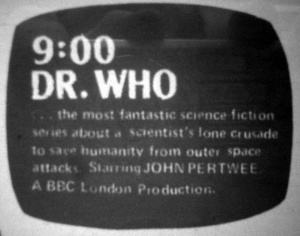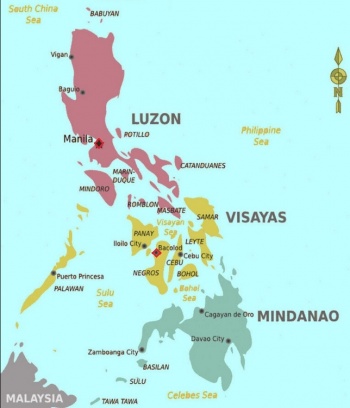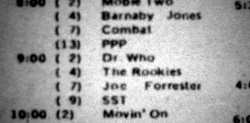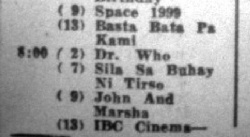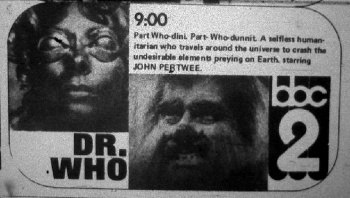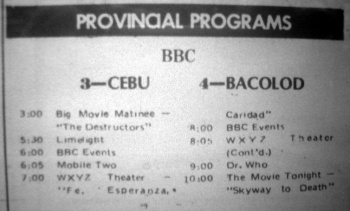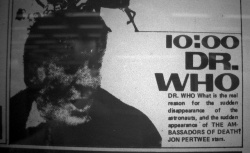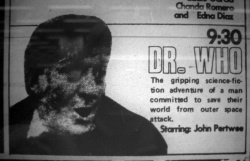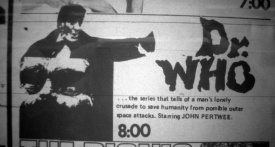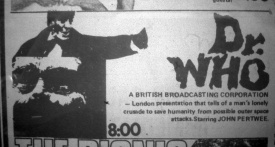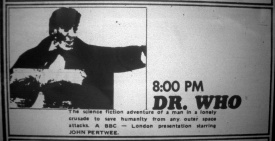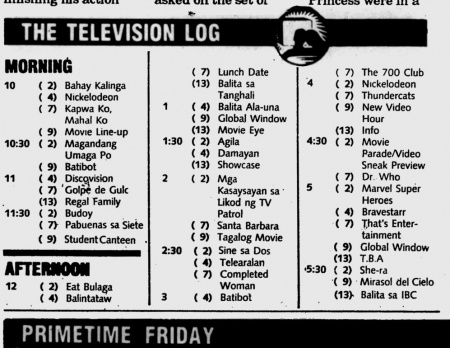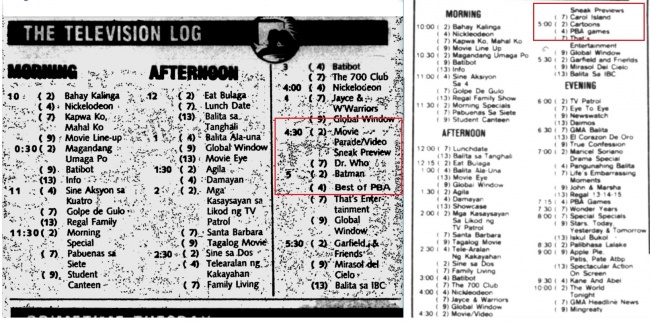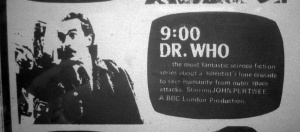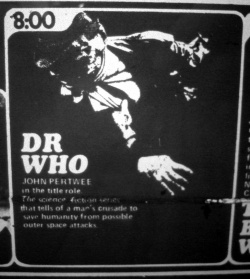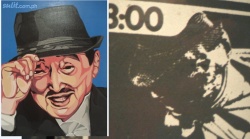Difference between revisions of "Philippines"
Jon Preddle (talk | contribs) (Created page with "==Links== *Broadcasts around the World *Articles & Analysis *BBC Records *Doctors *Spanish *Arabic *Bibliography") |
Jon Preddle (talk | contribs) |
||
| (35 intermediate revisions by 2 users not shown) | |||
| Line 1: | Line 1: | ||
| − | ==Links= | + | The '''[[Wikipedia:Philippines|PHILIPPINES]]''' is an archipelago of islands in the Pacific Ocean, to the south of [[Japan]], and north of [[Australia]]. |
| + | {{TOC right}} | ||
| + | ==Profile== | ||
| + | {| {{small-table}} | ||
| + | |- | ||
| + | |'''Country Number (39)'''||1976||[[Selling Doctor Who|SECOND WAVE]] | ||
| + | |- | ||
| + | |'''Region'''||[[:Category:Australasia/Asia|Asia]]|| | ||
| + | |- | ||
| + | |'''Television commenced'''||1953|| | ||
| + | |- | ||
| + | |'''Colour System'''||1966||[[:Wikipedia:NTSC|NTSC]] | ||
| + | |- | ||
| + | |'''[[WRTH|Population]]'''||1976||40,225,000 | ||
| + | |- | ||
| + | |'''[[WRTH|TV Sets]]'''||1974||450,000 | ||
| + | |- | ||
| + | |'''[[WRTH|Population]]'''||1987||56,000,000 | ||
| + | |- | ||
| + | |'''[[WRTH|TV Sets]]'''||1987||3,997,000 | ||
| + | |- | ||
| + | |'''Language/s'''||English|| | ||
| + | |- | ||
| + | |} | ||
| + | |||
| + | |||
| + | ==Television Stations / Channels== | ||
| + | [[File:ABS-CBN2.jpg|thumb|right|ABS-CBN channel 2 on which Doctor Who screened]] | ||
| + | '''Doctor Who''' has been aired in the Philippines by three different broadcasters: | ||
| + | |||
| + | In 1953, the Philippines was the first country in Asia to commence television broadcasts, with the '''[[wikipedia:ABS–CBN|ABS–CBN]]''' operating a network of transmitters across the islands. | ||
| + | |||
| + | NTSC colour transmissions commenced in 1966; even by the mid to late 1980s, more than half of the television sets in use were still only black and white. | ||
| + | |||
| + | In the 1970s, '''Doctor Who''' was screened by '''ABS-CBN''' on (at least) three of the islands: on Luzon, from Quezon City ('''Channel 2''' – also known as '''BBC2''', not to be confused with the British channel!); on Negros, from Bacolod (the capital of the Negros Occidental province) ('''Channel 4 / BBC4'''); and on Cebu, from Cebu City ('''Channel 3'''). (The series may well have aired on the other islands, but we don't have those airdates.) | ||
| + | |||
| + | * [[wikipedia:List_of_ABS–CBN_Broadcasting_Corporation_channels_and_stations| List of ABS–CBN channels and stations]] | ||
| + | |||
| + | ABS-CBN was, in its day, a major Philippine broadcaster, which later ran afoul of Philippine President Ferdinand Marcos and first lady Imelda Marcos during the long period of martial law post-1972. ABS-CBN 2 returned to the air by mid-1987 but was a shell of its former self until it was built back up, eventually becoming a powerhouse broadcaster. | ||
| + | |||
| + | In 1986, '''Doctor Who''' was available in the Philippines on the American [[Armed Forces Network]]'s Far East Network (FEN) – this is covered in the separate profile for that cable station. | ||
| + | |||
| + | In 1989, '''Doctor Who''' appeared on '''[[wikipedia:DZBB-TV|DZBB-TV]]''' aka '''GMA TV 7''', part of the '''[[Wikipedia:GMA Network|GMA Network]]'''. | ||
| + | |||
| + | Being the third TV station to be established in the Philippines (in 1961), GMA would legally purchase the rights to TV shows from a local distributor but instead of using the duped down video-tape copies that were usually provided, programmes were instead recorded off the air from stations in the US on high quality broadcast-quality tapes and shipped over to Quezon City, which gave GMA vastly superior picture quality over its rivals. (These broadcasts often still had local US TV station graphics on them!) This eventually got them into trouble with the Philippine Government as they were by-passing Asian companies and getting tapes from the USA even though they were supposed to acquire them locally. | ||
| + | |||
| + | GMA TV 7 had a very strong signal and was broadcast from Quezon City. By the late 1980s its new transmitter in the Visayas islands enabled broadcasts to be seen in a large part on the islands of Luzon and Cebu. | ||
| + | |||
| + | |||
| + | ==Language/s== | ||
| + | |||
| + | The principal languages of the Philippines is Pilipino, English (spoken by 50 percent of the population), Spanish, plus numerous native languages and dialects. Television broadcasts were predominantly in English. | ||
| + | |||
| + | |||
| + | =='''DOCTOR WHO IN THE PHILIPPINES'''== | ||
| + | |||
| + | The Philippines was the '''39th''' country to screen '''Doctor Who''', and the '''sixth''' in [[:Category:Australasia/Asia|Asia]] (see [[Selling Doctor Who]]). | ||
| + | |||
| + | |||
| + | ==[[BBC Records]]== | ||
| + | |||
| + | '''The Seventies''' records a sale of '''"(2)"''' stories by 28 February 1977. '''The Handbook''' identifies these as being {{LLL}} and {{NNN}}. | ||
| + | |||
| + | '''The Eighties''' [http://www.shillpages.com/howe/b-dw80s.htm - THE LOST CHAPTERS] records a sale of '''"(13)"''' stories (by 10 February 1987). There is an overlap of two stories across the 1977 and 1987 totals. | ||
| + | |||
| + | The post-February 1987 screenings of Tom Baker stories would not be included in this tally. | ||
| + | |||
| + | In '''DWM''', the Philippines is identified in '''six''' story Archives: {{DDD}}, {{EEE}}, {{KKK}}, {{MMM}}, {{LLL}}, {{NNN}}, with the year of sale given as '''1976''' or '''1977'''. | ||
| + | |||
| + | |||
| + | ='''ABS-CBN'''= | ||
| + | |||
| + | ==Stories bought and broadcast== | ||
| + | |||
| + | ===[[Jon Pertwee stories|JON PERTWEE]]=== | ||
| + | |||
| + | 13 stories, 72 episodes: | ||
| + | [[File:Phil DRWHO.JPG|thumb|right|300px]] | ||
| + | [[File:PhilippinesMap.jpg|thumb|right|350px|Map of Philippines; Quezon City / Manila on Luzon and Bacolod on Negros marked]] | ||
| + | [[File:Phil TV.JPG|thumb|right|250px|Generic 9.00pm listing for Channel 2, March 1976]] | ||
| + | [[File:Phil DW.JPG|thumb|right|250px|Generic 8.00pm listing for Channel 2, 1976]] | ||
| + | [[File:Phil AXOS.JPG|thumb|right|350px|Channel 2 listing, 20 March 1976; with Axon and Primord images]] | ||
| + | [[File:Phil BB2.JPG|thumb|right|350px|Generic 9.00pm listing for Cebu Channel 3 and Bacolod Channel 4, 1976]] | ||
| + | {| {{small-table}} | ||
| + | |- | ||
| + | |BBB||[[Doctor Who and the Silurians]]||7 | ||
| + | |- | ||
| + | |CCC||[[The Ambassadors of Death]]||7 | ||
| + | |- | ||
| + | |DDD||[[Inferno]]||7 | ||
| + | |- | ||
| + | |EEE||[[Terror of the Autons]]||4 | ||
| + | |- | ||
| + | |FFF||[[The Mind of Evil]]||6 | ||
| + | |- | ||
| + | |GGG||[[The Claws of Axos]]||4 | ||
| + | |- | ||
| + | |HHH||[[Colony in Space]]||6 | ||
| + | |- | ||
| + | |JJJ||[[The Daemons]]||5 | ||
| + | |- | ||
| + | |KKK||[[Day of the Daleks]]||4 | ||
| + | |- | ||
| + | |MMM||[[The Curse of Peladon]]||4 | ||
| + | |- | ||
| + | |LLL||[[The Sea Devils]]||6 | ||
| + | |- | ||
| + | |NNN||[[The Mutants]]||6 | ||
| + | |- | ||
| + | |OOO||[[The Time Monster]]||6 | ||
| + | |- | ||
| + | |} | ||
| + | |||
| + | ABS-CBN therefore bought GROUPs A to C of the standard package of [[Jon Pertwee stories]] sold in the NTSC colour format. | ||
| + | |||
| + | The programme was supplied as NTSC colour video tapes with English soundtracks. | ||
| + | |||
| + | ====Origin of the Tapes?==== | ||
| + | Although the Philippines is part of [[:Category:Australasia/Asia|Asia]], which is usually the jurisdiction of [[BBC Sydney]], the fact that the broadcaster transmits in NTSC suggests that the transmission tapes may have been supplied by Time-Life Films in New York. | ||
| + | |||
| + | Alternatively, [[Guam]], which is an adjacent island, sent its tapes to the Philippines after completion of its screenings in 1974. | ||
| + | |||
| + | |||
| + | ==Transmission== | ||
| + | |||
| + | ===[[Jon Pertwee stories|JON PERTWEE]]=== | ||
| + | |||
| + | The series was aired by '''ABS-CBN''' on a "regional" basis. We have located the airdates for two of these regional screenings -- on the islands of Luzon and Negros. It is highly likely that the series was available on the other islands, but newspapers and airdates for those have not been found. | ||
| + | |||
| + | |||
| + | '''QUEZON CITY (Channel 2)''' | ||
| + | |||
| + | Quezon City is one of the metropolitan districts of Manila on the island of Luzon. | ||
| + | |||
| + | The series commenced from Quezon City on Saturday, '''6 March 1976''', with a one-hour timeslot, 9.00 to 10.00pm, suggesting two episodes back to back. | ||
| + | |||
| + | From '''1 April''' the series moved to Thursdays, at the earlier time of 8.00pm, still in one hour / two episode blocks. | ||
| + | |||
| + | From '''20 August 1976''', it was a shift to Fridays, but now with only a half hour slot, starting 10.00pm for two weeks, then from 9.30pm for the final three weeks. | ||
| + | |||
| + | There were no episodes on '''29 April''', '''6 May''', '''1 July''', '''5 August''' and '''12 August'''. The TV listings pre-empt the series in favour of '''The Donny and Marie Show''' on '''22 July'''. However, it's possible that some of these listings are incorrect. | ||
| + | |||
| + | The last episode aired on '''17 September 1976'''. Assuming the series aired on '''15 April''' for which TV listings were not printed, there were 41 episodes in this run. However, there should be 42. | ||
| + | |||
| + | The number of pre-emptions on Channel 2 is mirrored by Channel 4 (see below), with the exception of '''The Donny and Marie Show''' which does not have a corresponding appearance in the Channel 4 listings a week later. Therefore the "missing" episode must have aired on one of the dates for which no episode is listed as airing. | ||
| + | |||
| + | But if one of the "pre-empted" dates did have '''Doctor Who''', that means our imbalance is now one ''more'' than the expected 42. | ||
| + | |||
| + | To make sense of this, back-to-back episodes of '''Doctor Who''' must have screened on some of the days it wasn't listed, or at least one of the usual double-episodes was actually just a single -- or combinations of both. | ||
| + | |||
| + | No episode titles were given, however (as noted in TV Listings below), the final serial to air appears to have been [[The Ambassadors of Death]]. | ||
| + | |||
| + | There is no clear record that '''Doctor Who''' aired on Channel 2 after this date -- see note below. | ||
| + | |||
| + | |||
| + | ---- | ||
| + | |||
| + | '''BACOLOD (Channel 4) / CEBU (Channel 3)''' | ||
| + | |||
| + | Viewers on the adjacent islands of Negros and Cebu (two of the islands in the Visayas region) saw '''Doctor Who''' a week after the Luzon / Quezon City broadcasts, starting Saturday '''13 March 1976''', at 9.00pm. These were also two episodes back to back in a one hour timeslot. | ||
| + | |||
| + | What's not clear from the listings is how these broadcasts were structured. Negros and Cebu are too far apart to receive the same signal and there were no repeater relays; they either played the '''same''' episode each night (in which case there was more than one tape copy of each episode), or each station aired a '''different''' episode / story at 9pm, with the tapes being exchanged until they had both aired all serials, albeit madly out of order. | ||
| + | |||
| + | From the second week, the start time shifted to 8.05pm. As with Quezon City, there was a day change to Thursday with the fourth episode. 8.00pm was the new airtime. | ||
| + | |||
| + | These Channel 3 and 4 screenings duplicated those of Quezon City, in that both have four pre-emptions, three of which are the same week. (This suggests that Bacolod received its tapes directly from Quezon City.) | ||
| + | |||
| + | There was a change to Fridays from '''27 August 1976''', with the timeslot given as 9.00 to 10.00pm. But if that timeslot length is correct, this gives us 48 episodes rather than 42. But if we assume the timeslot for these five Friday screenings was only half an hour (as it was on Channel 2) that leaves us with the same one extra episode imbalance of 43 rather than the expected 42. | ||
| + | |||
| + | As we've theorised above, it's possible that one of the usual advertised double-episodes was actually just a single, and that on one of the pre-empted dates, '''Doctor Who''' did actually air, or combinations of both. | ||
| + | |||
| + | The final episode of this run aired on Friday, '''24 September 1976'''. | ||
| + | |||
| + | |||
| + | '''Doctor Who''' returned to Bacolod's Channel 4 the following year. Corresponding listings for Quezon's Channel 2 could not be found, so the series either did not return at all (unlikely), or it did play but months earlier or later than on Negros, but for which listings could not be found. | ||
| + | |||
| + | After a ten month break, '''Doctor Who''' returned to Bacolod and Cebu on Friday, '''1 July 1977'''. For all 15 weeks, the timeslot was 8.30 to 9.30pm, which indicates two back to back episodes. The final episode on each station was on '''7 October 1977'''. | ||
| + | |||
| + | With 42 episodes expected in 1976 and 30 definite in 1977, Bacolod and Cebu screened all 72 episodes of the Jon Pertwee package during these two separate runs. | ||
| + | {{Image table | ||
| + | |[[File:Phil CCC.JPG|thumb|right|250px|Ambassadors of Death, Channel 2, 29 July 1976]] | ||
| + | |[[File:Phil CCC2.JPG|thumb|right|250px|Ambassadors of Death, Channel 2, 20 August 1976]] | ||
| + | |[[File:Phil DWC.JPG|thumb|right|250px |Generic listing, Channel 2, 3 September 1976]] | ||
| + | }} | ||
| + | {{Image table | ||
| + | |[[File:Phil DWWW.JPG|thumb|right|275px|Generic listing, Channel 2; Note the eyes of the Primord!]] | ||
| + | |[[File:Phil WHO2.JPG|thumb|right|275px|Variation of the same collage]] | ||
| + | |[[File:Phil WHO 4.JPG|thumb|right|275px|Another variation]] | ||
| + | }} | ||
| + | |||
| + | |||
| + | ---- | ||
| + | |||
| + | ='''[[Armed Forces Network|ARMED FORCES NETWORK]]'''= | ||
| + | |||
| + | In 1986, a run of [[Tom Baker stories]] in "omnibus" format would have been available to local viewers who lived near the various American forces bases dotted around the islands, such as navy stations US Naval Station Subic Bay, US Naval Air Station Cubi Point, and Naval Communications Station San Miguel, all of which were located in the provinces of Battan and Zambalaes; and US Air Force bases Clark Air Base, Wallace Air Station in Angeles City, Pampanga and in the Philippine Summer Capitol Baguio City, the home to Camp John Hay. | ||
| + | |||
| + | *[http://gallifreybase.com/w/index.php/Armed_Forces_Network#ARMED_FORCES_PHILIPPINES_NETWORK_.28AFPN.29 See separate page covering AFRTS: AFPN / FAR EAST NETWORK for background, transmission and listings] | ||
| + | |||
| + | |||
| + | ---- | ||
| + | |||
| + | ='''DZBB / GMA TV 7'''= | ||
| + | |||
| + | ==Stories bought and broadcast== | ||
| + | |||
| + | ===[[Tom Baker stories|TOM BAKER]]=== | ||
| + | |||
| + | Presumably these eight stories, 30 episodes: | ||
| + | {| {{small-table}} | ||
| + | |- | ||
| + | |4A||[[Robot]]||4 | ||
| + | |- | ||
| + | |4C||[[The Ark in Space]]||4 | ||
| + | |- | ||
| + | |4B||[[The Sontaran Experiment]]||2 | ||
| + | |- | ||
| + | |4D||[[Revenge of the Cybermen]]||4 | ||
| + | |- | ||
| + | |5J||[[Destiny of the Daleks]]||4 | ||
| + | |- | ||
| + | |5N||[[The Leisure Hive]]||4 | ||
| + | |- | ||
| + | |5Q||[[Meglos]]||4 | ||
| + | |- | ||
| + | |5R||[[Full Circle]]||4 | ||
| + | |- | ||
| + | |} | ||
| + | |||
| + | According to Robert Lia, who lived in the Philippines at this time, the stories that played on Quezon City's GMA channel 7 were the very same ones as the small package that aired in [[Malaysia]] from February 1986 to July 1987; these eight serials would therefore have been cleared for countries in the "Far East" region. | ||
| + | |||
| + | GMA therefore bought parts of GROUPs A and F of the [[Tom Baker stories]]. | ||
| + | |||
| + | The package available to GMA therefore included 14 episodes that AFRTS had screened (albeit as omnibus movies rather than episodically) and 16 new episodes that AFRTS did not screen. | ||
| + | |||
| + | The programme was supplied as NTSC colour video tapes with English soundtracks through Lionheart, or via an alternative means. (The Malaysian TV station was a PAL broadcaster, so although the two stations may have been sold the same package of eight serials, they did not share the same tapes.) | ||
| + | |||
| + | Robert recalls that some episodes aired with Lionheart Television distributor tags at the end. | ||
| + | |||
| + | However, these episodes may also have been acquired (officially or illicitly?) by recording off a PBS broadcast in the US onto high quality broadcast tapes, with the recordings then shipped over to Quezon City for screening; sales to the US were falling off by this time, which may have limited the availability of NTSC tapes that could be sent to GMA. So, although Lionheart may have sold the serials to GMA, the actual tapes themselves may have come via alternative sources. | ||
| + | |||
| + | If so, given that the piecemeal selection of the serials that were broadcast came from Tom Baker's first and final seasons, would they have all come from the same US station? Otherwise the person tasked with recording the episodes would have to wait months for each specific serial to air, and also run the risk of missing an episode (especially if they were recording only episodic rather than omnibus broadcasts). It's possible that several different stations across the US were used for the purpose of securing off-air recordings. | ||
| + | |||
| + | Of course, the person assigned to this task may have been instructed to record '''all''' the '''Doctor Who''' transmissions from the source station/s, but it was only later when GMA purchased the rights from the BBC to air the series that they were ultimately restricted to being able to screen only the select few that had been cleared for the Malaysian region. | ||
| + | |||
| + | |||
| + | ==Transmission== | ||
| + | |||
| + | ===[[Tom Baker stories|TOM BAKER]]=== | ||
| + | [[File:GMA4-8-89.jpg|thumb|right|450px|Dr Who on GMA channel 7, 4.30pm, 4 August 1989]] | ||
| + | The series started on Friday, '''4 August 1989''' at 4.30pm, running for half an hour. And from the following week, episodes aired three times a week, on the Tuesday, Wednesday and Friday. (The 4.30pm Monday and Thursday slots were taken by the Canadian series [[Wikipedia:Danger Bay|Danger Bay]].) | ||
| + | |||
| + | This 'three days a week' schedule continued for four weeks, until early September. '''Doctor Who''' has replaced '''Danger Bay''' in the Monday slot on '''11 September''' boosting the run to four episodes per week, but with no newspapers available for 4 September, it's not known whether '''Danger Bay''' was still playing or '''Doctor Who''' had already replaced it on that date. | ||
| + | |||
| + | For the next few weeks '''Doctor Who''' continued to air four times a week, with the Thursday slot still filled by '''Danger Bay''', which is a highly unusual scheduling choice, given that each 4-part '''Doctor Who''' serial would ''always'' be interrupted by either the Monday or Thursday episode of '''Danger Bay''' or by the weekend's programming. | ||
| + | |||
| + | The serials did not necessarily play in strict story order, as Robert recalls seeing [[Revenge of the Cybermen]], [[Destiny of the Daleks]], [[The Leisure Hive]] and [[Full Circle]] airing in that order (i.e. without [[Meglos]]). | ||
| + | |||
| + | But from mid-September, the newspaper listings go awry… | ||
| + | |||
| + | In the ''Manila Standard'', the available TV listings stop with the '''29 September 1989''' episode. None of the October issues were available online. The available newspaper collection recommences with the '''1 November''' issue, and '''Doctor Who''' is still listed four days per week (although three of the November papers have TV listings only from 6.30pm onwards.) | ||
| + | |||
| + | Listings for '''"Dr Who"''' continue to appear until '''29 November''', at which point the online newspaper collection stops again. It doesn't resume until 1 February 1990, and '''Doctor Who''' is no longer listed. The series therefore stopped at some point between 1 December 1989 and 31 January 1990. | ||
| + | |||
| + | |||
| + | However… | ||
| + | |||
| + | The ''Philippines Journal'' tells a different story. To start with the series appears as it is in the ''Manila Standard''. But it has '''"Dr Who"''' listed on Thursday, 14 November but not Friday, 15 November (it has '''Coral Island''' instead; see below) -- since '''Doctor Who''' didn't screen on Thursdays, the newspaper had probably switched the two days' listings around. | ||
| + | |||
| + | The last listing for '''"Dr Who"''' in the ''Journal'' is on Monday, 18 September, which is the 21st episode. From Tuesday, 19 September, the 4.30pm slot is taken by a 9-part Australian / UK series called '''[https://en.wikipedia.org/wiki/Coral_Island_(TV_series) Coral Island]''' (the paper sometimes misprints this as '''"Carol Island"'''!). And that was in turn replaced by episodes of the long-running US series '''[https://en.wikipedia.org/wiki/Sea_Hunt Sea Hunt]'''. The collection of the ''Journal'' runs to the end of the year, and '''Doctor Who''' does not appear again in any of them. | ||
| + | |||
| + | So, which of the two papers is correct? | ||
| + | |||
| + | If GMA did acquire the same package of 30 episodes as [[Malaysia]], and if the ''Journal'''s listings are correct, then only 21 episodes aired, which seems unlikely, unless one of the previous episodes had been pre-empted, or the 18 September listing itself is incorrect, giving an even run of 20 episodes, five 4-parters. | ||
| + | |||
| + | If '''Doctor Who''' was temporarily taken off the air to allow '''Coral Island''' to play, then the ''Standard'' was billing the entirely wrong programme for more than two weeks. And if '''Doctor Who''' did recommence once '''Coral Island''' had finished, why did the ''Journal'' continue to publish the wrong programme at 4.30pm for the rest of the year? | ||
| + | |||
| + | Without any October 1989 editions of the ''Standard'' available, we cannot determine whether there were any further discrepancies between the two sets of listings. But since '''Doctor Who''' does appear in all the available November issues of the ''Standard'', but not in any of the ''Journal'' listings for that month, which of the two papers is publishing the wrong listings? | ||
| + | [[File:PhilippinesCompare.jpg|thumb|right|650px|Contradictory TV listings at 4.30pm, 19 September 1989 – Manila Standard [Dr Who] vs Philippines Journal [Coral Island]]] | ||
| + | |||
| + | A close comparison of the two papers for 19 September shows an '''absolutely identical''' line-up in the morning, afternoon and evening programmes, '''except''' for what was airing at 4.30pm (Dr Who / Coral Island) and 5pm (Batman / Cartoons); why is there only a discrepancy in those two slots and none of the others? And why would the discrepancy continue for months without once being corrected? | ||
| + | |||
| + | It should be noted that the Philippines was in the midst of major political unrest at this point in its history, and because of that, television broadcasts would have been regularly disrupted, and what was printed in the newspapers may have been affected, so perhaps a breakdown in communication between the broadcaster and the various newspapers meant that the wrong TV listings were sometimes published, even for an entire month? | ||
| + | |||
| + | With potentially 30 episodes to account for (per the table above), it's '''possible''' that '''Doctor Who''' aired for 30 dates (until 2 October, but with ''Philippines Journal'' incorrectly listing '''Coral Island''' for the last nine episodes). It was replaced by '''Coral Island''' for nine days, with the ''Journal'' correctly billing the series (those issues are missing for the ''Standard'' so we have no idea what they said was screening). '''Doctor Who''' was then ''repeated'' from 17 October to 6 December, with the ''Standard'' correctly billing all episodes but the ''Journal'' publishing the wrong schedule. | ||
| + | |||
| + | But with such contradictory listings from 19 September onwards, our airdates table will never be wholly accurate; we therefore list only the dates on which '''Doctor Who''' was billed in the ''Manila Standard'' during 1989, but that does not necessarily mean it did actually screen on all those dates beyond 18 September. | ||
| + | |||
| + | |||
| + | =TV listings= | ||
| + | {{airdates-left|}} | ||
| + | |||
| + | TV listings for the 1970s have been obtained from the ''Bulletin Today'' and ''Philippines Daily Express''. The 1989 listings are from the ''Philippines Journal'' and the online archived editions of the ''Manila Standard''. | ||
| + | |||
| + | All listings gave the series name as '''"Dr Who"'''. No story titles were provided. | ||
| + | [[File:Phil WHO.JPG|thumb|right|300px|Who is this man?? Clue: It's not Jon Pertwee! 13 March 1976]] | ||
| + | [[File:Phil NOTDW.JPG|thumb|right|250px|This is NOT from Doctor Who!, 15 July 1976]] | ||
| + | [[File:DolphyHat2.jpg|thumb|right|250px|Dolphy – is this the man in the "mystery" photo?]] | ||
| + | |||
| + | Aside from the standard TV schedule tables, the ''Daily Express'' also printed elsewhere in the paper a half-page "TELEVISION TODAY" section, which featured a gallery of images advertising the programmes featuring that evening. But for only a few weeks during the 1976 run, '''Doctor Who''' always featured in these galleries. | ||
| + | |||
| + | The images used were generally a cut-and-paste of cropped publicity photos of Jon Pertwee – or '''JOHN PERTWEE''' as the newspaper often credited. Sometimes the photo gallery was the same, but the accompanying text was different. Three of images had the eyes of a Primord from [[Inferno]] plastered on top of Pertwee! | ||
| + | |||
| + | The photos for '''29 July''' and '''20 August 1976''' name the episodes as being [[The Ambassadors of Death]], which are the only two instances in which a story title is given. This suggests that the serials did not necessarily air in correct story order. | ||
| + | |||
| + | There were no gallery images for the 1977 run. | ||
| + | |||
| + | Two of the 1976 gallery photos have us completely stumped, as they are clearly '''NOT''' from '''Doctor Who''': | ||
| + | *'''13 March 1976''': The photo is of a man (with a moustache?) who is clearly NOT Jon Pertwee, but who bears a slight resemblance to actors Donald Sutherland and Christopher Lee. (The shadowing on his face makes it look as though he is wearing an eyepatch!) | ||
| + | *'''15 July 1976''': In this photo of two men (neither of whom is Jon Pertwee!), one appears to be grasping and/or supporting the other, whose head and face looks to be disfigured, and is wearing a hat and cloak. | ||
| + | |||
| + | It is possible that the July 1976 image is from a film starring '''[[Wikipedia:Dolphy|Dolphy]]''', the Philippines' "King of Comedy". This portrait of the actor with hat does bear a striking resemblance to the figure in the "mystery" photo. Of note, one of Dolphy's 1965 films was called '''"Dr Yes"!''' | ||
| + | :*'''If you are able to identify the films or TV programmes these images are from, please drop us a line! ''' | ||
| + | |||
| + | |||
| + | The 1989 GMA details are from online editions of ''[https://news.google.com/newspapers?nid=8cBNEdFwSQkC Manila Standard]'', many of which are missing (specifically October and December 1989 and January 1990). | ||
| + | |||
| + | Those airdates were cross-matched with listings in the ''Philippines Journal'', which, as detailed above, were often not the same: according to the ''Journal'', '''Doctor Who''' did not air at all during October, November or December 1989, despite the ''Standard'' listing the series during November! But it's certain from the available editions of the ''Standard'' that the series had definitely concluded by 1 February 1990. | ||
| + | |||
| + | |||
| + | =The Philippines in Doctor Who= | ||
| + | |||
| + | * In [[The Talons of Weng-Chiang]], the Doctor mentions having been with the Filipino Army during its advance on Reykjavik in the 51st century. | ||
| + | |||
| + | |||
| + | |||
| + | =Links= | ||
| + | *[[Main Page]] | ||
*[[Broadcasts around the World]] | *[[Broadcasts around the World]] | ||
*[[Articles & Analysis]] | *[[Articles & Analysis]] | ||
*[[BBC Records]] | *[[BBC Records]] | ||
*[[Doctors]] | *[[Doctors]] | ||
| − | *[[ | + | **[[Jon Pertwee stories]] |
| − | *[[ | + | **[[Tom Baker stories]] |
| − | + | ||
| + | |||
| + | [[Category:Australasia/Asia]] | ||
Latest revision as of 20:13, 16 December 2020
The PHILIPPINES is an archipelago of islands in the Pacific Ocean, to the south of Japan, and north of Australia.
Profile
| Country Number (39) | 1976 | SECOND WAVE |
| Region | Asia | |
| Television commenced | 1953 | |
| Colour System | 1966 | NTSC |
| Population | 1976 | 40,225,000 |
| TV Sets | 1974 | 450,000 |
| Population | 1987 | 56,000,000 |
| TV Sets | 1987 | 3,997,000 |
| Language/s | English |
Television Stations / Channels
Doctor Who has been aired in the Philippines by three different broadcasters:
In 1953, the Philippines was the first country in Asia to commence television broadcasts, with the ABS–CBN operating a network of transmitters across the islands.
NTSC colour transmissions commenced in 1966; even by the mid to late 1980s, more than half of the television sets in use were still only black and white.
In the 1970s, Doctor Who was screened by ABS-CBN on (at least) three of the islands: on Luzon, from Quezon City (Channel 2 – also known as BBC2, not to be confused with the British channel!); on Negros, from Bacolod (the capital of the Negros Occidental province) (Channel 4 / BBC4); and on Cebu, from Cebu City (Channel 3). (The series may well have aired on the other islands, but we don't have those airdates.)
ABS-CBN was, in its day, a major Philippine broadcaster, which later ran afoul of Philippine President Ferdinand Marcos and first lady Imelda Marcos during the long period of martial law post-1972. ABS-CBN 2 returned to the air by mid-1987 but was a shell of its former self until it was built back up, eventually becoming a powerhouse broadcaster.
In 1986, Doctor Who was available in the Philippines on the American Armed Forces Network's Far East Network (FEN) – this is covered in the separate profile for that cable station.
In 1989, Doctor Who appeared on DZBB-TV aka GMA TV 7, part of the GMA Network.
Being the third TV station to be established in the Philippines (in 1961), GMA would legally purchase the rights to TV shows from a local distributor but instead of using the duped down video-tape copies that were usually provided, programmes were instead recorded off the air from stations in the US on high quality broadcast-quality tapes and shipped over to Quezon City, which gave GMA vastly superior picture quality over its rivals. (These broadcasts often still had local US TV station graphics on them!) This eventually got them into trouble with the Philippine Government as they were by-passing Asian companies and getting tapes from the USA even though they were supposed to acquire them locally.
GMA TV 7 had a very strong signal and was broadcast from Quezon City. By the late 1980s its new transmitter in the Visayas islands enabled broadcasts to be seen in a large part on the islands of Luzon and Cebu.
Language/s
The principal languages of the Philippines is Pilipino, English (spoken by 50 percent of the population), Spanish, plus numerous native languages and dialects. Television broadcasts were predominantly in English.
DOCTOR WHO IN THE PHILIPPINES
The Philippines was the 39th country to screen Doctor Who, and the sixth in Asia (see Selling Doctor Who).
BBC Records
The Seventies records a sale of "(2)" stories by 28 February 1977. The Handbook identifies these as being LLL and NNN.
The Eighties - THE LOST CHAPTERS records a sale of "(13)" stories (by 10 February 1987). There is an overlap of two stories across the 1977 and 1987 totals.
The post-February 1987 screenings of Tom Baker stories would not be included in this tally.
In DWM, the Philippines is identified in six story Archives: DDD, EEE, KKK, MMM, LLL, NNN, with the year of sale given as 1976 or 1977.
ABS-CBN
Stories bought and broadcast
JON PERTWEE
13 stories, 72 episodes:
| BBB | Doctor Who and the Silurians | 7 |
| CCC | The Ambassadors of Death | 7 |
| DDD | Inferno | 7 |
| EEE | Terror of the Autons | 4 |
| FFF | The Mind of Evil | 6 |
| GGG | The Claws of Axos | 4 |
| HHH | Colony in Space | 6 |
| JJJ | The Daemons | 5 |
| KKK | Day of the Daleks | 4 |
| MMM | The Curse of Peladon | 4 |
| LLL | The Sea Devils | 6 |
| NNN | The Mutants | 6 |
| OOO | The Time Monster | 6 |
ABS-CBN therefore bought GROUPs A to C of the standard package of Jon Pertwee stories sold in the NTSC colour format.
The programme was supplied as NTSC colour video tapes with English soundtracks.
Origin of the Tapes?
Although the Philippines is part of Asia, which is usually the jurisdiction of BBC Sydney, the fact that the broadcaster transmits in NTSC suggests that the transmission tapes may have been supplied by Time-Life Films in New York.
Alternatively, Guam, which is an adjacent island, sent its tapes to the Philippines after completion of its screenings in 1974.
Transmission
JON PERTWEE
The series was aired by ABS-CBN on a "regional" basis. We have located the airdates for two of these regional screenings -- on the islands of Luzon and Negros. It is highly likely that the series was available on the other islands, but newspapers and airdates for those have not been found.
QUEZON CITY (Channel 2)
Quezon City is one of the metropolitan districts of Manila on the island of Luzon.
The series commenced from Quezon City on Saturday, 6 March 1976, with a one-hour timeslot, 9.00 to 10.00pm, suggesting two episodes back to back.
From 1 April the series moved to Thursdays, at the earlier time of 8.00pm, still in one hour / two episode blocks.
From 20 August 1976, it was a shift to Fridays, but now with only a half hour slot, starting 10.00pm for two weeks, then from 9.30pm for the final three weeks.
There were no episodes on 29 April, 6 May, 1 July, 5 August and 12 August. The TV listings pre-empt the series in favour of The Donny and Marie Show on 22 July. However, it's possible that some of these listings are incorrect.
The last episode aired on 17 September 1976. Assuming the series aired on 15 April for which TV listings were not printed, there were 41 episodes in this run. However, there should be 42.
The number of pre-emptions on Channel 2 is mirrored by Channel 4 (see below), with the exception of The Donny and Marie Show which does not have a corresponding appearance in the Channel 4 listings a week later. Therefore the "missing" episode must have aired on one of the dates for which no episode is listed as airing.
But if one of the "pre-empted" dates did have Doctor Who, that means our imbalance is now one more than the expected 42.
To make sense of this, back-to-back episodes of Doctor Who must have screened on some of the days it wasn't listed, or at least one of the usual double-episodes was actually just a single -- or combinations of both.
No episode titles were given, however (as noted in TV Listings below), the final serial to air appears to have been The Ambassadors of Death.
There is no clear record that Doctor Who aired on Channel 2 after this date -- see note below.
BACOLOD (Channel 4) / CEBU (Channel 3)
Viewers on the adjacent islands of Negros and Cebu (two of the islands in the Visayas region) saw Doctor Who a week after the Luzon / Quezon City broadcasts, starting Saturday 13 March 1976, at 9.00pm. These were also two episodes back to back in a one hour timeslot.
What's not clear from the listings is how these broadcasts were structured. Negros and Cebu are too far apart to receive the same signal and there were no repeater relays; they either played the same episode each night (in which case there was more than one tape copy of each episode), or each station aired a different episode / story at 9pm, with the tapes being exchanged until they had both aired all serials, albeit madly out of order.
From the second week, the start time shifted to 8.05pm. As with Quezon City, there was a day change to Thursday with the fourth episode. 8.00pm was the new airtime.
These Channel 3 and 4 screenings duplicated those of Quezon City, in that both have four pre-emptions, three of which are the same week. (This suggests that Bacolod received its tapes directly from Quezon City.)
There was a change to Fridays from 27 August 1976, with the timeslot given as 9.00 to 10.00pm. But if that timeslot length is correct, this gives us 48 episodes rather than 42. But if we assume the timeslot for these five Friday screenings was only half an hour (as it was on Channel 2) that leaves us with the same one extra episode imbalance of 43 rather than the expected 42.
As we've theorised above, it's possible that one of the usual advertised double-episodes was actually just a single, and that on one of the pre-empted dates, Doctor Who did actually air, or combinations of both.
The final episode of this run aired on Friday, 24 September 1976.
Doctor Who returned to Bacolod's Channel 4 the following year. Corresponding listings for Quezon's Channel 2 could not be found, so the series either did not return at all (unlikely), or it did play but months earlier or later than on Negros, but for which listings could not be found.
After a ten month break, Doctor Who returned to Bacolod and Cebu on Friday, 1 July 1977. For all 15 weeks, the timeslot was 8.30 to 9.30pm, which indicates two back to back episodes. The final episode on each station was on 7 October 1977.
With 42 episodes expected in 1976 and 30 definite in 1977, Bacolod and Cebu screened all 72 episodes of the Jon Pertwee package during these two separate runs.
ARMED FORCES NETWORK
In 1986, a run of Tom Baker stories in "omnibus" format would have been available to local viewers who lived near the various American forces bases dotted around the islands, such as navy stations US Naval Station Subic Bay, US Naval Air Station Cubi Point, and Naval Communications Station San Miguel, all of which were located in the provinces of Battan and Zambalaes; and US Air Force bases Clark Air Base, Wallace Air Station in Angeles City, Pampanga and in the Philippine Summer Capitol Baguio City, the home to Camp John Hay.
DZBB / GMA TV 7
Stories bought and broadcast
TOM BAKER
Presumably these eight stories, 30 episodes:
| 4A | Robot | 4 |
| 4C | The Ark in Space | 4 |
| 4B | The Sontaran Experiment | 2 |
| 4D | Revenge of the Cybermen | 4 |
| 5J | Destiny of the Daleks | 4 |
| 5N | The Leisure Hive | 4 |
| 5Q | Meglos | 4 |
| 5R | Full Circle | 4 |
According to Robert Lia, who lived in the Philippines at this time, the stories that played on Quezon City's GMA channel 7 were the very same ones as the small package that aired in Malaysia from February 1986 to July 1987; these eight serials would therefore have been cleared for countries in the "Far East" region.
GMA therefore bought parts of GROUPs A and F of the Tom Baker stories.
The package available to GMA therefore included 14 episodes that AFRTS had screened (albeit as omnibus movies rather than episodically) and 16 new episodes that AFRTS did not screen.
The programme was supplied as NTSC colour video tapes with English soundtracks through Lionheart, or via an alternative means. (The Malaysian TV station was a PAL broadcaster, so although the two stations may have been sold the same package of eight serials, they did not share the same tapes.)
Robert recalls that some episodes aired with Lionheart Television distributor tags at the end.
However, these episodes may also have been acquired (officially or illicitly?) by recording off a PBS broadcast in the US onto high quality broadcast tapes, with the recordings then shipped over to Quezon City for screening; sales to the US were falling off by this time, which may have limited the availability of NTSC tapes that could be sent to GMA. So, although Lionheart may have sold the serials to GMA, the actual tapes themselves may have come via alternative sources.
If so, given that the piecemeal selection of the serials that were broadcast came from Tom Baker's first and final seasons, would they have all come from the same US station? Otherwise the person tasked with recording the episodes would have to wait months for each specific serial to air, and also run the risk of missing an episode (especially if they were recording only episodic rather than omnibus broadcasts). It's possible that several different stations across the US were used for the purpose of securing off-air recordings.
Of course, the person assigned to this task may have been instructed to record all the Doctor Who transmissions from the source station/s, but it was only later when GMA purchased the rights from the BBC to air the series that they were ultimately restricted to being able to screen only the select few that had been cleared for the Malaysian region.
Transmission
TOM BAKER
The series started on Friday, 4 August 1989 at 4.30pm, running for half an hour. And from the following week, episodes aired three times a week, on the Tuesday, Wednesday and Friday. (The 4.30pm Monday and Thursday slots were taken by the Canadian series Danger Bay.)
This 'three days a week' schedule continued for four weeks, until early September. Doctor Who has replaced Danger Bay in the Monday slot on 11 September boosting the run to four episodes per week, but with no newspapers available for 4 September, it's not known whether Danger Bay was still playing or Doctor Who had already replaced it on that date.
For the next few weeks Doctor Who continued to air four times a week, with the Thursday slot still filled by Danger Bay, which is a highly unusual scheduling choice, given that each 4-part Doctor Who serial would always be interrupted by either the Monday or Thursday episode of Danger Bay or by the weekend's programming.
The serials did not necessarily play in strict story order, as Robert recalls seeing Revenge of the Cybermen, Destiny of the Daleks, The Leisure Hive and Full Circle airing in that order (i.e. without Meglos).
But from mid-September, the newspaper listings go awry…
In the Manila Standard, the available TV listings stop with the 29 September 1989 episode. None of the October issues were available online. The available newspaper collection recommences with the 1 November issue, and Doctor Who is still listed four days per week (although three of the November papers have TV listings only from 6.30pm onwards.)
Listings for "Dr Who" continue to appear until 29 November, at which point the online newspaper collection stops again. It doesn't resume until 1 February 1990, and Doctor Who is no longer listed. The series therefore stopped at some point between 1 December 1989 and 31 January 1990.
However…
The Philippines Journal tells a different story. To start with the series appears as it is in the Manila Standard. But it has "Dr Who" listed on Thursday, 14 November but not Friday, 15 November (it has Coral Island instead; see below) -- since Doctor Who didn't screen on Thursdays, the newspaper had probably switched the two days' listings around.
The last listing for "Dr Who" in the Journal is on Monday, 18 September, which is the 21st episode. From Tuesday, 19 September, the 4.30pm slot is taken by a 9-part Australian / UK series called Coral Island (the paper sometimes misprints this as "Carol Island"!). And that was in turn replaced by episodes of the long-running US series Sea Hunt. The collection of the Journal runs to the end of the year, and Doctor Who does not appear again in any of them.
So, which of the two papers is correct?
If GMA did acquire the same package of 30 episodes as Malaysia, and if the Journal's listings are correct, then only 21 episodes aired, which seems unlikely, unless one of the previous episodes had been pre-empted, or the 18 September listing itself is incorrect, giving an even run of 20 episodes, five 4-parters.
If Doctor Who was temporarily taken off the air to allow Coral Island to play, then the Standard was billing the entirely wrong programme for more than two weeks. And if Doctor Who did recommence once Coral Island had finished, why did the Journal continue to publish the wrong programme at 4.30pm for the rest of the year?
Without any October 1989 editions of the Standard available, we cannot determine whether there were any further discrepancies between the two sets of listings. But since Doctor Who does appear in all the available November issues of the Standard, but not in any of the Journal listings for that month, which of the two papers is publishing the wrong listings?
A close comparison of the two papers for 19 September shows an absolutely identical line-up in the morning, afternoon and evening programmes, except for what was airing at 4.30pm (Dr Who / Coral Island) and 5pm (Batman / Cartoons); why is there only a discrepancy in those two slots and none of the others? And why would the discrepancy continue for months without once being corrected?
It should be noted that the Philippines was in the midst of major political unrest at this point in its history, and because of that, television broadcasts would have been regularly disrupted, and what was printed in the newspapers may have been affected, so perhaps a breakdown in communication between the broadcaster and the various newspapers meant that the wrong TV listings were sometimes published, even for an entire month?
With potentially 30 episodes to account for (per the table above), it's possible that Doctor Who aired for 30 dates (until 2 October, but with Philippines Journal incorrectly listing Coral Island for the last nine episodes). It was replaced by Coral Island for nine days, with the Journal correctly billing the series (those issues are missing for the Standard so we have no idea what they said was screening). Doctor Who was then repeated from 17 October to 6 December, with the Standard correctly billing all episodes but the Journal publishing the wrong schedule.
But with such contradictory listings from 19 September onwards, our airdates table will never be wholly accurate; we therefore list only the dates on which Doctor Who was billed in the Manila Standard during 1989, but that does not necessarily mean it did actually screen on all those dates beyond 18 September.
TV listings
| ← AIRDATES ...... (CLICK ICON TO GO TO TABLE SHOWING EPISODE BREAKDOWN AND AIRDATES - N/S = story title is Not Stated) |
TV listings for the 1970s have been obtained from the Bulletin Today and Philippines Daily Express. The 1989 listings are from the Philippines Journal and the online archived editions of the Manila Standard.
All listings gave the series name as "Dr Who". No story titles were provided.
Aside from the standard TV schedule tables, the Daily Express also printed elsewhere in the paper a half-page "TELEVISION TODAY" section, which featured a gallery of images advertising the programmes featuring that evening. But for only a few weeks during the 1976 run, Doctor Who always featured in these galleries.
The images used were generally a cut-and-paste of cropped publicity photos of Jon Pertwee – or JOHN PERTWEE as the newspaper often credited. Sometimes the photo gallery was the same, but the accompanying text was different. Three of images had the eyes of a Primord from Inferno plastered on top of Pertwee!
The photos for 29 July and 20 August 1976 name the episodes as being The Ambassadors of Death, which are the only two instances in which a story title is given. This suggests that the serials did not necessarily air in correct story order.
There were no gallery images for the 1977 run.
Two of the 1976 gallery photos have us completely stumped, as they are clearly NOT from Doctor Who:
- 13 March 1976: The photo is of a man (with a moustache?) who is clearly NOT Jon Pertwee, but who bears a slight resemblance to actors Donald Sutherland and Christopher Lee. (The shadowing on his face makes it look as though he is wearing an eyepatch!)
- 15 July 1976: In this photo of two men (neither of whom is Jon Pertwee!), one appears to be grasping and/or supporting the other, whose head and face looks to be disfigured, and is wearing a hat and cloak.
It is possible that the July 1976 image is from a film starring Dolphy, the Philippines' "King of Comedy". This portrait of the actor with hat does bear a striking resemblance to the figure in the "mystery" photo. Of note, one of Dolphy's 1965 films was called "Dr Yes"!
- If you are able to identify the films or TV programmes these images are from, please drop us a line!
The 1989 GMA details are from online editions of Manila Standard, many of which are missing (specifically October and December 1989 and January 1990).
Those airdates were cross-matched with listings in the Philippines Journal, which, as detailed above, were often not the same: according to the Journal, Doctor Who did not air at all during October, November or December 1989, despite the Standard listing the series during November! But it's certain from the available editions of the Standard that the series had definitely concluded by 1 February 1990.
The Philippines in Doctor Who
- In The Talons of Weng-Chiang, the Doctor mentions having been with the Filipino Army during its advance on Reykjavik in the 51st century.

